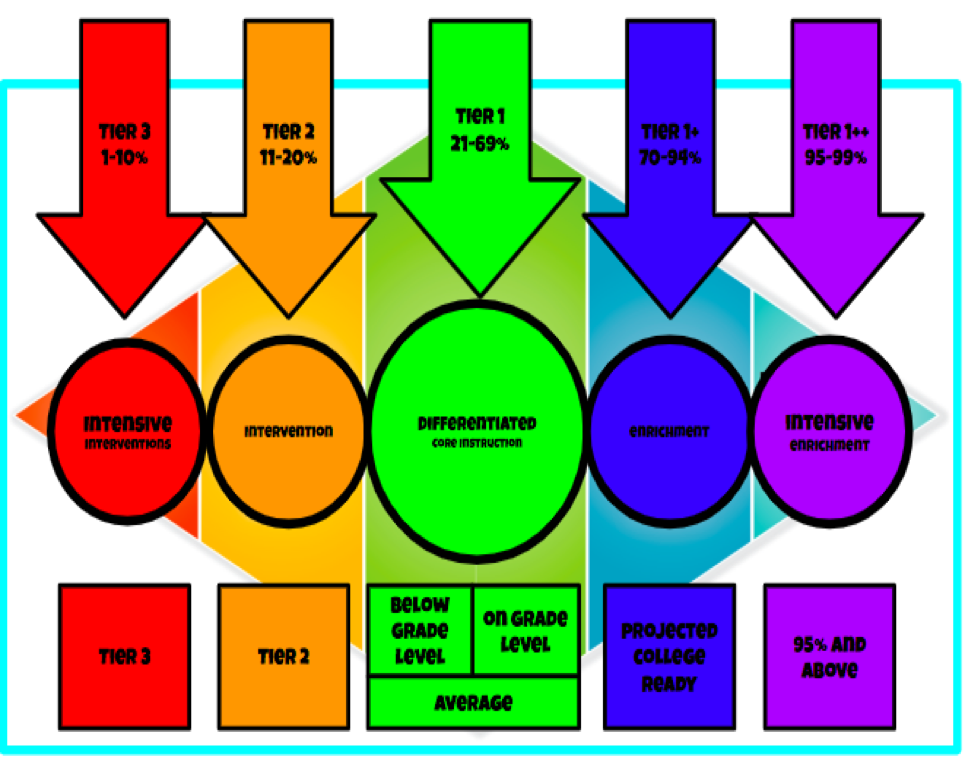Multi-Tiered System of Support (MTSS) Overview
MTSS Problem-Solving Team MTSS Flow Chart
MTSS Guidelines and Expectations
District 97 MTSS Diamond System
A diamond system of service delivery is a necessary structure to efficiently and effectively support all children, not just those who struggle in school. The diamond system of service delivery is crucial to ensure all students achieve at high levels and progress on to college and career readiness.
The first step in building an MTSS system involves examining system effectiveness, which must occur prior to examining each individual student. This section describes each tier in detail, and how to examine the effectiveness of a school’s system of service delivery.
Tier 1, Tier + (Tier Plus) and Tier ++ (Tier Plus Plus) Core Instruction
At Tier 1, all students receive scientific, research-based core instruction implemented with integrity and emphasizing grade-level standards and school-wide behavioral expectations. Instruction at Tier 1 should be explicit, differentiated and include flexible grouping and active student engagement. To ensure 80% of students’ needs are met at Tier 1, high quality instruction is essential. Features of high quality, research-based instruction include (Chard et al., 2008):
- Standards-Based Curriculum: A curriculum based upon the Common Core State Standards (or district standards).
- Systematic Explicit Instruction: Skills are taught from less to more complex using direct, clear and concise instructional language.
- Differentiated Instruction: Students have different levels of background knowledge and school readiness. Differentiated instruction engages each student in active learning according to their needs. The content of instruction, delivery of instruction, and targeted level of instruction can be differentiated.
- Flexible Grouping: A combination of whole group, small group, and individual instruction allows teachers to create fluid groups that meet the needs of all students.
- Active Student Engagement: Ensuring all students are actively involved during instruction and are not passive recipients. This can be accomplished with high rates of opportunities to respond, ample time to practice skills and prompt corrective feedback.
- Classroom Behavior Strategies: Proactively and explicitly teaching the expected behaviors and routines, frequent use of reinforcement and praise (3:1 positive to negative feedback loop), quick and efficient transition times and consistent instructional response to misbehavior.
A solid Tier 1, Tier + (Tier Plus) and Tier ++ (Tier Plus Plus) core instruction should be sufficient to help 80% of students meet or exceed grade level expectations as measured by a standardized summative assessment. If Tier 1 instruction is not successful in meeting the needs of 80% of the school’s population, the school team should consider possible solutions to create a better match between students’ needs and the core curriculum and instruction (e.g., improving explicit instruction, differentiation strategies, use of flexible grouping and maximizing active student engagement).
Core instruction is linguistically appropriate for English Learners (ELs) and Bilingual Learners. All students—including ELs/bilingual learners, students with disabilities, early childhood and advanced/gifted learners—are expected to meet grade-level learning targets and beyond. For ELs and bilingual learners, this means achieving mastery at a proportionate rate to their language proficiency. For students in early childhood, this means progress across developmental areas and developmentally appropriate instruction and activities.
Differentiation begins in Tier 1 and continues across all tiers. Differentiation requires teachers to recognize students’ varying levels of readiness, interest, background knowledge, and culture. When teachers differentiate they respond and proactively plan for differing abilities in the same classroom. Differentiation can occur through modifications in content (what is taught), process (how it is taught), product (how learning is shown), and/or environment or resources available in the classroom (seating, support materials from curriculum). (Tomlinson, 1999).
Tier 1, Tier + and Tier ++Enrichment and Support (Core + More)
Students who are meeting or exceeding standards may require enrichment beyond the core to demonstrate academic growth. It is the school’s responsibility to ensure that all students make academic progress regardless of their entry level. Targeted group enrichment and support typically involve additional minutes of instruction provided each week within the classroom or in some cases outside of the classroom with a classroom teacher and/or interventionist/ specialist.
Tier 2 Targeted Group Intervention
At Tier 2, students identified as being at-risk academically or behaviorally through universal screeners are provided scientific, research-based interventions in addition to the core. Tier 2 interventions are implemented with groups of students demonstrating common skill deficits or social/emotional/behavioral risk characteristics.
Targeted group interventions typically involve an additional minutes of instruction (outside of core instruction) provided each week. Targeted group interventions must be more explicit: more intensive than core instruction; more supportive in the form of encouragement, feedback, and positive reinforcement; carefully scaffolded; and occur in smaller groups.
Tier 3 Intensive Individualized Intervention
Students who have not demonstrated progress with targeted group interventions at Tier 2 require more time in more intensive interventions. Tier 3 interventions are distinguished from Tier 2 interventions because they are individualized, based on data collected in individual problem solving, occur with smaller student-teacher ratios, and possibly occur for a longer duration of time. About 5% to 10% of students will require this level of intensive support. Strategies for maximizing student outcomes during core instruction, as well as support at home or in the community need to be part of this support.
Progress Monitoring
The purpose of monitoring progress is to determine the effectiveness of an intervention plan on student learning. When data show students are progressing, interventions are maintained until students meet identified goals. When data show students are not progressing, a change in intervention is necessary (Fuchs, Compton, Fuchs & Davis, 2008). When changes are made to intervention plans based on data, intervention or phase lines should be placed on student graphs to indicate the change. Students receiving Tier 2 support should be progressed monitored every other week, while students receiving Tier 3 support should be progressed monitored weekly.

